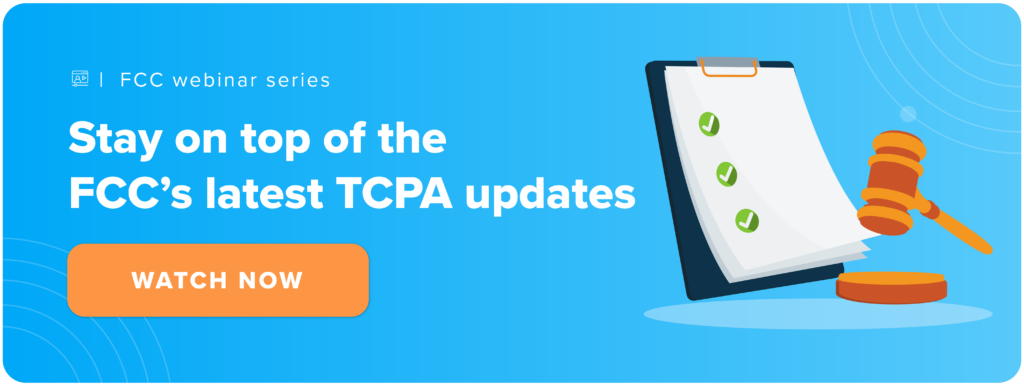How strategic partnerships help you navigate risks and maximize rewards

In our recent webinar, “Partnering for success: Navigating risk and reward in lead gen”, expert speakers Michael Peronto, Director of Professional Services at ActiveProspect, and Dan Lilly, Compliance Officer at Excel, delved into the impending shifts in industry regulations – specifically the FCC’s forthcoming one-to-one consent rules.
These changes are set to bear profound ramifications for the lead generation and performance marketing industry. Our panelists covered the impact of these changes on web form design and how lead providers and lead buyers should work together to identify compliance requirements and potential risks.
How lead providers and buyers can tackle the upcoming one-to-one consent rule changes together
As Dan explains, to ensure lead buyers and generators are aligned, they should begin by examining potential contractual requirements when engaging with lead partners. As you might know, contracts are typically required by both parties and these take time to finalize.
According to Dan, it’s crucial to understand what is permissible and what is not, especially with the upcoming FCC one-to-one consent changes. Coordination with legal teams is essential to ensure compliance, as requirements may vary among partners.
Next, Dan advises to discuss the differing expectations among partners. When working with multiple lead generators, each may operate differently, and your requirements might vary. It’s important to approach this with a plan, clearly communicating your requirements and gathering theirs to make informed decisions.
Lastly, understanding timelines is vital. Knowing when lead generators plan to test the one-to-one consent requirements can help you anticipate potential impacts on your operations, as Dan points out.
Michael also highlights how, beyond lead generators, there are other partners like CRM technology providers that must be considered. You’ll need to discuss specific flags and reporting features to filter records based on one-to-one consent status. And, as Michael stresses, communicating your requirements to vendors should happen well in advance, as they’ll need time to implement the requested changes.

How web form design impacts lead generation, compliance, and brand experience
According to Dan, lead buyers and lead generators need to discuss and plan for the details seen on-screen, such as consent capture methods. A significant challenge buyers face is whether publishers use pre-checked or unchecked boxes, as legal teams may have varying opinions on this.
It’s crucial to align on the required language, as it may differ from what lead generators expect. Early conversations allow lead generators to implement the correct disclosure language with their partners.
Understanding the impact of pre-checked or unchecked boxes on lead volume is also essential, says Dan. This ties into your organization’s risk tolerance. Pre-checked boxes may result in a minimal decrease in opportunities, while unchecked boxes could significantly lower lead volume, as consumers must actively check options.
Therefore, in order to maintain lead volume with unchecked boxes, you might need to significantly raise your bid to secure the top position. According to Dan, each decision you make may affect the available lead volume and its cost.
And what about lead intent? Will these changes alter the overall intent of your traffic? Dan anticipates minimal impact, but he can’t guarantee that for all publishers.

As Michael explains, you might find that some of these changes actually benefit your bottom line. Leads could have higher contact and conversion rates, potentially allowing you to consider buying more records from various publishers and lead providers.

What to do if your publisher can’t accommodate your requests
When making requests to lead generators or publishers, remember that you’re not their only client. Hundreds of partners may have similar or different requests, and it’s not feasible for publishers to accommodate everyone. According to Dan’s professional experience, often the largest buyers significantly influence publishers’ decisions, and other partners tend to align with those changes.
Dan suggests reaching out to your lead sellers to share your concerns and requests, but keep in mind that not all may be met. Instead, use this opportunity to discuss how they can help you achieve your goals in other ways. This might involve higher costs or stricter compliance requirements, but ultimately, it’s about having open conversations with your lead sellers to find solutions that work for you, even if there’s a slight reduction in shared traffic.
Moreover, engaging with your lead generators has its advantages, as they can provide insights into their perspectives. As Dan explains, for instance, in the Medicare sector, if major players like UHC and Humana are endorsing a particular approach that works for most companies, your lead generators might share this information. You can then discuss this with your legal or compliance team, mentioning that this is the direction UHC is taking, and explore if you can align with it.
Typically, according to Dan, once key industry players adopt a certain path, legal teams become more at ease, as they are following an established industry trend rather than forging their own. Therefore, having these conversations is crucial.
What should a lead buyer discuss with their lead providers on handling post rejections?
As Dan explains, the most significant change with the FCC’s one-to-one consent is the reduced space on the publisher’s site to display partner names. Publishers will send out customer information, receive bids, and select the best fit for the consumer to display.
Part of this selection process involves evaluating how often you reject leads after they’re posted. This is crucial because once a lead is sent, there’s no going back. Lead generators can’t revisit the customer for additional consent if a buyer rejects the lead, potentially reducing their monetization significantly.
To manage this, publishers may devalue you in the bidding environment if you have a high rejection rate. For instance, if you reject 50% of leads based on your scoring, your bids could be devalued by 50% because publishers know there’s a 50/50 chance you won’t accept the lead, leading to lost opportunities.
It’s essential to maintain low post-reject numbers and discuss this with your publishers. They can provide insights into why leads are being rejected, which could be due to simple errors like address validation issues. While these might be reasons for rejection now, they may need reconsideration in the future, especially if they occur frequently.
According to Dan, open communication is key. You don’t need to share all the details of your lead scoring, but helping publishers understand potential issues can enable them to work with you to resolve problems rather than making unilateral decisions.
What should lead buyers consider about ping response time and how it affects them?
In this new environment, as explained by Dan, ping response time is crucial. If your responses are delayed—whether due to system issues or lengthy lead checks—you risk being excluded from the auction altogether.
For instance, if the average partner response time is one second and yours is 10 or 15 seconds, the publisher might not wait and will proceed without considering your bid, even if it’s the highest. This is because the customer experience is paramount; delays can lead to customer drop-offs, especially if additional questions are asked to fill the wait time.
Therefore, Dan advises to know your ping response time and explore ways to expedite it. Auctions now happen in milliseconds, and publishers will proceed with the timely bids that meet their criteria, leaving slow responders behind.
Important talking points about company names, DBAs, and partner names
One of the most critical steps to ensure success and minimize liability, according to Dan, is to promptly provide accurate company name information to your publishers. They need to display the winning entity’s name, and legally, they can only show the name you provide. This could be your full company name, your DBA, or even the names of 1099 agents if they are individual LLCs. Compliance with partner contracts often includes meticulous attention to documentation and the nuances of what legal agreements such as an LLC operating agreement entail. Aligning these formal documents is crucial for maintaining transparency and aligning expectations when establishing lead-generation partnerships.
Why is this so important? Many 1099 agents didn’t anticipate their LLC names being customer-facing and thus didn’t prioritize creativity. If your LLC name lacks appeal, consider getting a suitable DBA.

It’s crucial to have these discussions because publishers can only share the names you provide. If there’s an error, it’s challenging to rectify once the information is out there. Most publishers have likely already contacted you about this legal requirement, so ensure you’re giving them the correct names to display.

Capture and store proof of consent with TrustedForm
TrustedForm is the ultimate compliance solution for documenting TCPA consent on digital lead capture forms.
TrustedForm helps brands:
- Document TCPA consent and capture exactly when and where your contacts have requested communication.
- Access and store proof of consent for five years in case they need it to address potential litigation.
- Optimize the consent capture process by enabling users to identify and categorize TCPA consent language for different lead vendors.
And with our newest feature, TrustedForm Verify 1:1 Consent Check, you can also programmatically verify that each lead has given one-to-one consent to be contacted. This feature helps you remain compliant with the latest FCC regulations and reduces the risk of penalties in a scalable manner.
Get in touch now and we will help you get started with TrustedForm Verify 1:1 Consent Check!

Takeaways
Here’s some key takeaways we were able to gather from our recent webinar “Partnering for success: Navigating risk and reward in lead gen”:
- Effective communication and collaboration between lead providers and lead buyers is key to navigate the upcoming FCC one-to-one consent rules and related updates to the TCPA.
- Web form design will have an impact in terms of compliance, lead volumes, and consumer experience. The implications of web form design will impact various partners, including CRM and technology partners who need to adapt to different changes.
- Understanding timelines and managing expectations is vital in order to successfully navigate the changes brought about by the new FCC one-to-one consent rules. Lead buyers need to coordinate with lead generators regarding their testing schedules and potential implementation dates for compliance changes.
- A lead vendor may not be able to meet the compliance changes requested by a lead buyer. In such cases, consider alternative lead generation strategies. Also, consider your lead rejection rates in the ping post model, as a high lead rejection rate could affect your value in the auction.
- ActiveProspect offers a compliance solution for capturing consumer consent and managing one-to-one consent and consent language.
Never miss a TCPA update with ActiveProspect! Watch the entire episode now and subscribe to our FCC webinar series to stay in the loop with expert insights.

DISCLAIMER: This page and all related links are provided for general informational and educational purposes only and are not legal advice. ActiveProspect does not warrant or guarantee this information will provide you with legal protection or compliance. Please consult with your legal counsel for legal and compliance advice. You are responsible for using any ActiveProspect Services in a legally compliant manner pursuant to ActiveProspect’s Terms of Service. Any quotes contained herein belong to the person(s) quoted and do not necessarily represent the views and/or opinions of ActiveProspect.

